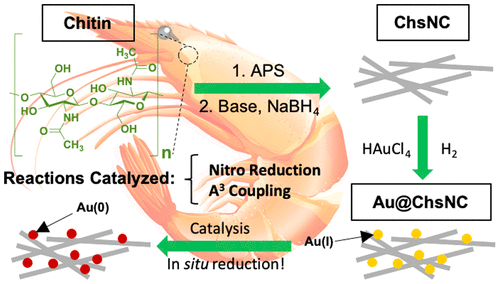当前位置:
X-MOL 学术
›
Biomacromolecules
›
论文详情
Our official English website, www.x-mol.net, welcomes your
feedback! (Note: you will need to create a separate account there.)
Carboxylated Chitosan Nanocrystals: A Synthetic Route and Application as Superior Support for Gold-Catalyzed Reactions.
Biomacromolecules ( IF 5.5 ) Pub Date : 2020-03-30 , DOI: 10.1021/acs.biomac.0c00201 Tony Jin 1 , Davis Kurdyla 1, 2 , Sabahudin Hrapovic 2 , Alfred C W Leung 2 , Sophie Régnier 2 , Yali Liu 2 , Audrey Moores 1, 3 , Edmond Lam 2
Biomacromolecules ( IF 5.5 ) Pub Date : 2020-03-30 , DOI: 10.1021/acs.biomac.0c00201 Tony Jin 1 , Davis Kurdyla 1, 2 , Sabahudin Hrapovic 2 , Alfred C W Leung 2 , Sophie Régnier 2 , Yali Liu 2 , Audrey Moores 1, 3 , Edmond Lam 2
Affiliation

|
In this study, we demonstrate for the first time the fabrication of carboxylated chitosan nanocrystals (ChsNC) with high degree of deacetylation (DDA) at >80% and narrow size distribution. We also studied its application as a sustainable support material for metal-based catalysts. Carboxylated chitin nanocrystals (ChNCs) were initially prepared through partial cleavage of glycosidic bonds in chitin by ammonium persulfate, with concurrent oxidation of chitin C6 primary alcohols to produce carboxylate groups on the surface of the ChNCs. ChsNCs were subsequently prepared using an alkaline deacetylation procedure in the presence of NaBH4 to preserve the nanorod structure of the biomaterial. The resulting nanocrystals feature both carboxyl and amino functional groups. Transmission electron microscopy (TEM), X-ray diffraction (XRD), and Fourier-transform infrared (FTIR) spectroscopy were used to determine the morphology and composition of these carboxylated ChNCs and ChsNCs. Subsequently, we tested the ability of the as-made ChsNCs as a biomass-based catalyst support for Au nanoparticles (NPs) using the 4-nitrophenol reduction and the aldehyde–amine–alkyne (A3) coupling reactions to demonstrate its capabilities in regard to the ones of cellulose nanocrystals (CNCs). In particular, Au NPs over ChsNCs featured the highest turnover frequency (TOF) value for the 4-nitrophenol reduction reported for all Au-based catalysts supported on carbon-based systems. Spectroscopic and imaging techniques confirmed the importance of precisely controlling the redox state of Au as it is being deposited to afford a highly disperse active site on the bionano-support.
中文翻译:

羧化壳聚糖纳米晶体:合成路线和应用为金催化反应的高级支持。
在这项研究中,我们首次证明了羧化壳聚糖纳米晶体(ChsNC)的脱乙酰度(DDA)高,> 80%,粒径分布窄。我们还研究了其作为金属基催化剂的可持续载体材料的应用。羧基化的几丁质纳米晶体(ChNCs)最初是通过用过硫酸铵部分裂解几丁质中的糖苷键而制备的,同时氧化几丁质C6伯醇在ChNCs的表面上产生羧基。随后在NaBH 4存在下使用碱性脱乙酰化程序制备ChsNC保留生物材料的纳米棒结构。所得的纳米晶体同时具有羧基和氨基官能团。透射电子显微镜(TEM),X射线衍射(XRD)和傅立叶变换红外(FTIR)光谱用于确定这些羧基化的ChNCs和ChsNCs的形态和组成。随后,我们使用4-硝基苯酚还原和醛-胺-炔烃(A 3)测试了制成的ChsNCs作为金纳米颗粒(NPs)的基于生物质的催化剂载体的能力。)偶联反应以证明其在纤维素纳米晶体(CNC)方面的能力。尤其是,ChsNC上的Au NP的特征在于,据报道,碳基系统上支持的所有Au基催化剂的4-硝基苯酚还原均具有最高的周转频率(TOF)值。光谱和成像技术证实了精确控制金的氧化还原状态的重要性,因为金的沉积是为了在仿生纳米载体上提供高度分散的活性位。
更新日期:2020-03-30
中文翻译:

羧化壳聚糖纳米晶体:合成路线和应用为金催化反应的高级支持。
在这项研究中,我们首次证明了羧化壳聚糖纳米晶体(ChsNC)的脱乙酰度(DDA)高,> 80%,粒径分布窄。我们还研究了其作为金属基催化剂的可持续载体材料的应用。羧基化的几丁质纳米晶体(ChNCs)最初是通过用过硫酸铵部分裂解几丁质中的糖苷键而制备的,同时氧化几丁质C6伯醇在ChNCs的表面上产生羧基。随后在NaBH 4存在下使用碱性脱乙酰化程序制备ChsNC保留生物材料的纳米棒结构。所得的纳米晶体同时具有羧基和氨基官能团。透射电子显微镜(TEM),X射线衍射(XRD)和傅立叶变换红外(FTIR)光谱用于确定这些羧基化的ChNCs和ChsNCs的形态和组成。随后,我们使用4-硝基苯酚还原和醛-胺-炔烃(A 3)测试了制成的ChsNCs作为金纳米颗粒(NPs)的基于生物质的催化剂载体的能力。)偶联反应以证明其在纤维素纳米晶体(CNC)方面的能力。尤其是,ChsNC上的Au NP的特征在于,据报道,碳基系统上支持的所有Au基催化剂的4-硝基苯酚还原均具有最高的周转频率(TOF)值。光谱和成像技术证实了精确控制金的氧化还原状态的重要性,因为金的沉积是为了在仿生纳米载体上提供高度分散的活性位。











































 京公网安备 11010802027423号
京公网安备 11010802027423号